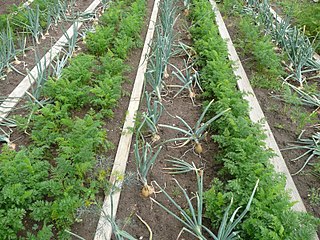
Companion planting in gardening and agriculture is the planting of different crops in proximity for any of a number of different reasons, including pest control, pollination, providing habitat for beneficial insects, maximizing use of space, and to otherwise increase crop productivity. Companion planting is a form of polyculture.

Boesenbergia rotunda, Thai กระชาย krachai, commonly known as Chinese keys, fingerroot, lesser galangal or Chinese ginger, is a medicinal and culinary herb from China and Southeast Asia. In English, the root has traditionally been called fingerroot, because the shape of the rhizome resembles that of fingers growing out of a center piece.

Sedum is a large genus of flowering plants in the family Crassulaceae, members of which are commonly known as stonecrops. The genus has been described as containing up to 600 species, subsequently reduced to 400–500. They are leaf succulents found primarily in the Northern Hemisphere, but extending into the southern hemisphere in Africa and South America. The plants vary from annual and creeping herbs to shrubs. The plants have water-storing leaves. The flowers usually have five petals, seldom four or six. There are typically twice as many stamens as petals. Various species formerly classified as Sedum are now in the segregate genera Hylotelephium and Rhodiola.
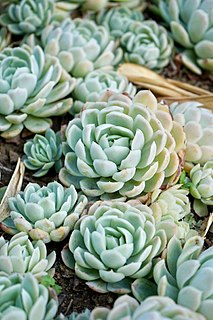
Echeveria is a large genus of flowering plants in the family Crassulaceae, native to semi-desert areas of Central America, Mexico and northwestern South America.
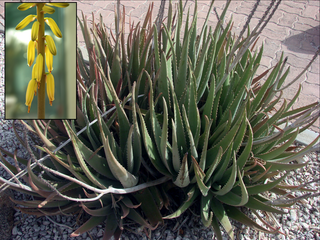
Aloe vera is a succulent plant species of the genus Aloe. An evergreen perennial, it originates from the Arabian Peninsula, but grows wild in tropical, semi-tropical, and arid climates around the world. It is cultivated for agricultural and medicinal uses. The species is also used for decorative purposes and grows successfully indoors as a potted plant.

Cinnamomum tamala, Indian bay leaf, also known as tejpat, tezapatta,Malabar leaf, Indian bark, Indian cassia, or malabathrum, is a tree in the family Lauraceae that is native to India, Bangladesh, Nepal, Bhutan, and China. It can grow up to 20 m (66 ft) tall. Its leaves have a clove-like aroma with a hint of peppery taste; they are used for culinary and medicinal purposes. It is thought to have been one of the major sources of the medicinal plant leaves known in classic and medieval times as malabathrum.

A plant cutting is a piece of a plant that is used in horticulture for vegetative (asexual) propagation. A piece of the stem or root of the source plant is placed in a suitable medium such as moist soil. If the conditions are suitable, the plant piece will begin to grow as a new plant independent of the parent, a process known as striking. A stem cutting produces new roots, and a root cutting produces new stems. Some plants can be grown from leaf pieces, called leaf cuttings, which produce both stems and roots. The scions used in grafting are also called cuttings.

A leaf miner is any one of numerous species of insects in which the larval stage lives in, and eats, the leaf tissue of plants. The vast majority of leaf-mining insects are moths (Lepidoptera), sawflies, and flies (Diptera), though some beetles also exhibit this behavior.

Talinum paniculatum is a succulent subshrub in the family Talinaceae that is native to much of North and South America, and the Caribbean countries. It is commonly known as fameflower, Jewels-of-Opar, or pink baby's-breath.

Graptopetalum paraguayense is a species of succulent plant in the jade plant family, Crassulaceae, that is native to Tamaulipas, Mexico. Common names include Sedum weinbergii, Mother-of-pearl-plant and Ghost plant. This is not to be confused with Monotropa uniflora which is also referred to as the “Ghost plant”. G. paraguayense has white flowers which have a form of a star.

Eryngium amethystinum, the amethyst eryngo, Italian eryngo or amethyst sea holly, is a clump-forming, perennial, tap-rooted herb. Its stem is 30 to 50 cm long and is light blue to purple in colour. It has a basal circle of obovate, pinnate, spiny, leathery, mid-green leaves. It flowers in mid to late summer with cylindrical umbels, 2–3 cm long atop silvery blue bracts and branching stems. The plant is native to the eastern Mediterranean and prefers dry places and soils that are rich in calcium.

Protea laurifolia, also known as the grey-leaf sugarbush, is a shrub from South Africa. It is native to the Cape Provinces of South Africa.
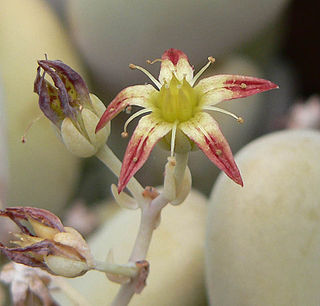
Graptopetalum (leatherpetal) is a plant genus of the family Crassulaceae. They are perennial succulent plants and native to Mexico and Arizona. They grow usually in a rosette. There are around 19 species in this genus.
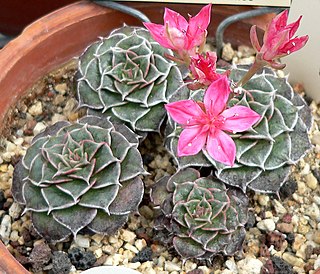
Graptopetalum bellum is a species of flowering plant in the stonecrop family Crassulaceae, native to northern Mexico. It was discovered by Alfred Lau in 1972 in the states of Chihuahua and Sonora, at an altitude of 1,460 m (4,800 ft).
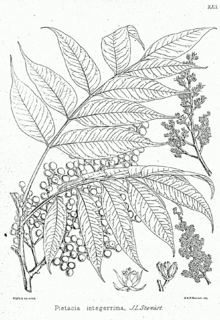
Pistacia integerrima is a species of pistachio tree native to Asia, commonly called zebrawood. It is often classified as Pistacia chinensis ssp. integerrima. It is used for a variety of purposes in India, including timber, dye, and fodder. The leaf galls are used in traditional herbalism for cough, asthma, fever, vomiting, and diarrhea.

Graptopetalum bartramii is a species of succulent plant known as Bartram's stonecrop and Patagonia Mountain leatherpetal.
Commiphora africana, commonly called African myrrh, is a small deciduous tree belonging to the Burseraceae, a family akin to the Anacardiaceae, occurring widely over sub-Saharan Africa in Angola, Botswana, Burkina Faso, Chad, Eritrea, Ethiopia, Kenya, Mali, Mauritania, Mozambique, Namibia, Niger, Senegal, Somalia, South Africa, Sudan, Swaziland, Tanzania, Uganda, Zambia and Zimbabwe. On sandy soils this species sometimes forms pure stands, deserving consideration as a plant community or association.
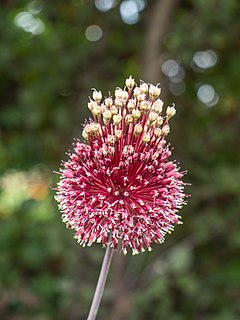
Allium amethystinum is a plant species native to Italy, Greece, Turkey, Sicily, Crete, Malta, Albania, Bulgaria, and the former Yugoslavia, and cultivated elsewhere as an ornamental. It is one of several species that horticulturalists refer to as "drumstick onions" because of the tight spherical "knob" of flowers at the top, resembling a drumstick.
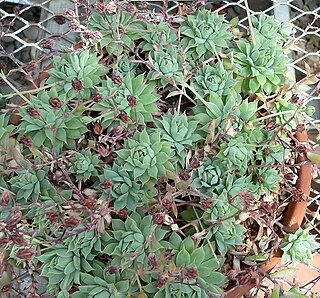
Graptopetalum macdougallii is a plant belonging to the succulent genus Graptopetalum. It is native to Mexico. It grows on shady rocks, or rarely as an epiphyte, at an altitude of 1200 – 2100 meters, geographically isolated from all other Graptopetalum species.
Protea scabra, also known as the sandpaper-leaf sugarbush, is a flowering groundcover that belongs to the genus Protea. The plant is endemic to South Africa and is found from the Hottentots Holland Mountains across the Riviersonderend Mountains, the Kleinrivier Mountains and around the town of Caledon to the Swartberg mountains.



















